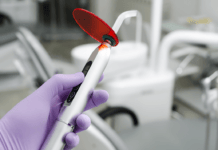Definition of Yoga
1: a system of physical postures, breathing techniques, and sometimes meditation derived from Yoga but often practiced independently, especially in Western cultures, to promote physical and emotional well-being.
Kim Stabbe, a registered dental hygienist (RDH)/yoga instructor from Fremont, Nebraska, began her career in 1982 as a clinical RDH and then began teaching at a community college in 1986. That is where she took her first yoga class offered as part of the college’s wellness program. Having experienced carpal tunnel issues in her dominant wrist, as well a neck and back pain, she found yoga helpful at the end of her busy days of teaching to release tightness in her shoulders, back, and hips.
Kim states, “I wish I had started practicing yoga in my early years of dental hygiene, as I recognize it’s benefits to physical and mental health well-being.”
Yoga Benefits for Students
Being an instructor, Kim recognized increases in poor posture and an increase in musculoskeletal issues in her students. She feels that the increase in electronics usage was a likely contributing factor. During her yoga training, she explained yoga to her dental hygiene students and incorporated it in her teachings to help her hygiene students gain energy, calm down, stretch areas, gain strength, and become aware of their posture/alignment. This is an interesting concept that may need to be a consideration for all hygiene programs to promote adopting early practice to bring forth awareness to ergonomics/body issues.
When instructing yogis, Kim focuses strongly on alignment as it is vital to prevent injury. She states, “Yoga works toward achieving stability and comfort which is helped by proper alignment which starts with the foundation of the yoga pose. Always remember that yoga should not cause pain. If you are in a pose that is causing pain, then stop just like in your dental hygiene practice when if what you are doing is causing you pain then you should stop.”
Another recommendation is that individuals practice with a certified yoga instructor, rather than by doing a video at home. An instructor can assist each client with their specific needs, unlike just following guidance from a video. Perhaps a student has a fused back; they will need different instruction than the student with a shoulder issue.
Becoming a Yoga Teacher
Kim’s yoga journey began at the community college. However, she recognized that she was gaining so much from the practice that she invested in classes at a studio, which eventually led her to yoga teacher training. During the training, she was able to increase her knowledge in yoga poses, alignment, health benefits, and so much more that she could not gain through larger studio classes.
Her yoga training was a 200-hours course that is accredited through Yoga Alliance. Kim has been teaching yoga since 2013. She found that her dental hygiene teaching background fits wonderfully with teaching yoga. She has assisted many types of students including a variety of ages. Some of these students had mobility issues that prevented easy access to the floor, which prompted Kim to obtain an additional certification for senior and chair yoga principles.
Kim teaches at local community centers, the local library, and Blue Yoga Studio in Fremont. She also found that chair yoga was beneficial to corporate desk workers and dental professionals alike and completed a corporate yoga certification. To honor our veterans, Kim likewise completed the Mindful Resilience Training through the Veterans Yoga Project. She is currently trying to connect with area veterans to offer free yoga to them and their family members as a way to thank them for their service. She considers all types of individuals and their needs!
Balancing Yoga with Hygiene
Kim has ascertained some parallelisms between yoga and dental hygiene. She states, “Because I am a lifelong learner, I know I need to continually learn more to help each of my students on their yoga journey to health in both mind and body. I continue to take yoga continuing education courses, just as we do for our RDH licenses, yearly to increase my knowledge of how best to teach and provide yoga for all. Both the dental hygienist and the yoga teacher tries to help clients become healthier. A good yoga teacher and dental hygienist are both very detail-oriented, which is needed in both professions to provide the best care for the client.”
Speaking of the mind component to yoga practice, Kim shared that yoga offers breath work (pranayama) that helps calm the mind and bring forth greater concentration throughout the student’s yoga practice. It allows them to be present in the moment and forget about the comings and goings of busy schedules and days.
Hygienists are asked to balance physicality and mentality in their schedules. Therefore, concentrating on breathing can offer refocus, which can bring forth calm. Breathing must continue throughout yoga practice to maintain focus and presence. A final meditative posture (savasana) is vital to creating a calm, presence, reduction of blood pressure, sleep improvements, and reduction of stress. Anyone can use these benefits, but hygienists should truly consider and value them from the start through the end of their careers.
Yoga Options for Hygienists
Hygienists can choose to implement various yoga poses in the dental operatory throughout the day. Wrist, hand, and neck stretches will allow for better functionality and health. Kim offered other suggestions, such as being seated in a chair doing a forward fold. A twist and a backbend are great ways to keep the hips and back feeling good.
A seated thread-the-needle is another great way to try to decrease tight hips and aid the health of the low back. Extending a leg out from a seated position and leaning over the leg to stretch out the back of the leg/hamstring will help decrease back and/or hip pain. While these are only a few options, a chair yoga class can offer a larger variety.
Additional classes that hygienists may appreciate could be yin, restorative, vinyasa flow, Iyengar (poses with props), or chair yoga. All would be beneficial for the physical and mental aspects faced by busy dental hygienists. Just making the conscious decision to take any yoga class is the best way to start to stress reduction, create calmness and increase core strength, and musculoskeletal health. These principles are essential in being a healthy, happy dental hygienist.
Lastly, simply focusing on the musculoskeletal system, in general, can help avoid issues. With the posture leaning forward with a pelvic tilt/from the hips, don’t bring head too far forward/down, and try to keep the spine long and maintain its natural curves. Keep feet planted on the floor other than during rheostat use. Wrists should maintain a neutral position with instrumentation and local anesthetic administration. Use backbend fitted loupes with a light, which can assist in good posture and alignments.
With dental hygiene being a demanding career, hygienists must explore all facets of maintaining a healthy, functional musculoskeletal system. Kim Stabbe has given incredible insight to musculoskeletal maintenance through ergonomic review, while also sharing a plethora of information regarding her love of yoga and how incorporating it into dental hygiene practice can manifest healthier dental hygienists from a physical and mental health perspective. How incredible to receive this information via a former clinical hygienist, turned hygiene educator, and yoga instructor.












